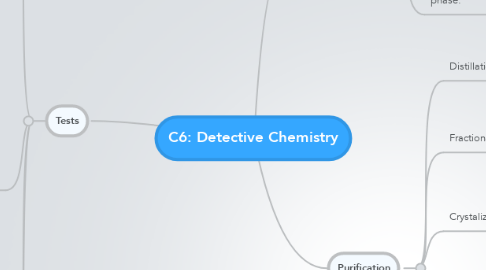
1. Tests
1.1. Anions
1.1.1. Chloride Ions
1.1.1.1. Test
1.1.1.1.1. Acidify 2cm of sample with diluted nitric acid, and then add silver nitrate solution.
1.1.1.2. Positive Result
1.1.1.2.1. A white precipitate is formed, that turns purple when in contact with sunlight.
1.1.2. Carbonate Ions
1.1.2.1. Test
1.1.2.1.1. Add 2cm of diluted HCl to the sample, collect any gas produced, and then bubble it through limewater.
1.1.2.2. Positive Result
1.1.2.2.1. A colourless odourless gas is formed that reacts with colourless limewater to form a white precipitate
1.1.3. Sulphate Ions
1.1.3.1. Test
1.1.3.1.1. Acidify 2cm of sample with dilute HCl, and then add barium chloride solution.
1.1.3.2. Positive Result
1.1.3.2.1. A white precipitate, barium sulphate, is formed
1.1.4. Ammonium Ions
1.1.4.1. Test
1.1.4.1.1. Add 2cm of 1M sodium hydroxide solution to 2cm of sample solution and warm solution in water bath. Hold moist red litmus paper over the test tube,
1.1.4.2. Positive Result
1.1.4.2.1. A toxic smelly gas is produced that turns the paper blue.
1.1.5. Nitrate Ions
1.1.5.1. Test
1.1.5.1.1. Add 2cm of 1M sodium hydroxide to 2cm of sample solution, and add a small pinch of aluminium powder (catalyst). Hold moist red litmus paper over a test tube producing the gas.
1.1.5.2. Positive Result
1.1.5.2.1. A toxic smelly gas is produced that turns the paper blue.
1.2. Cations
1.2.1. Ammonium
1.2.1.1. Sodium Hydroxide
1.2.1.1.1. Ammonia gas produced on warning
1.2.1.2. Ammonium Hydroxide
1.2.1.2.1. None
1.2.2. Copper
1.2.2.1. Sodium Hydroxide
1.2.2.1.1. Light blue precipitate, insoluble in excess
1.2.2.2. Ammonium Hydroxide
1.2.2.2.1. Light blue precipitate, insoluble in excess, leaving behind a dark blue solution
1.2.3. Iron (II)
1.2.3.1. Sodium Hydroxide
1.2.3.1.1. Green precipitate, insoluble in excess
1.2.3.2. Ammonium Hydroxide
1.2.3.2.1. Green precipitate, insoluble in excess
1.2.4. Iron (III)
1.2.4.1. Sodium Hydroxide
1.2.4.1.1. Red brown precipitate, insoluble in excess
1.2.4.2. Ammonium Hydroxide
1.2.4.2.1. Red brown precipitate, insoluble in excess
1.2.5. Zinc
1.2.5.1. Sodium Hydroxide
1.2.5.1.1. White precipitate, soluble in excess giving a colourless solution.
1.2.5.2. Ammonium Hydroxide
1.2.5.2.1. White precipitate, soluble in excess giving a colourless solution.
1.2.6. Tests
1.2.6.1. Sodium Hydroxide
1.2.6.1.1. Sodium Hydroxide is added to the solution, in small amounts, and then in excess.
1.2.6.2. Ammonium Hydroxide
1.2.6.2.1. Ammonium Hydroxide is added to the solution, in small amounts, and then in excess.
1.3. Gases
1.3.1. Oxygen
1.3.1.1. Glowing splint test: A glowing splint is placed into a test tube containing oxygen, and if present, the splint re-lights.
1.3.2. Hydrocen
1.3.2.1. Squeaky-pop test: A lit splint is placed into a test tube containing hydrogen, and if present, a pop can be heard.
1.3.3. Carbon DIoxide
1.3.3.1. Limewater test: To test for CO2, the gas is collected, and bubbled through limewater. If present, the lime water turns cloudy to form a white precipitate.
1.3.4. Ammonia
1.3.4.1. Litmus paper test: A damp piece of red litmus paper is placed over a test tube of a solution producing ammonia. If present, the litmus paper will slowly turn blue.
1.3.5. Chlorine
1.3.5.1. Litmus paper test: A damp blue piece of litmus paper is placed over a solution producing chlorine. If present, the paper will turn red, and then bleach white.
1.4. Water
1.4.1. Copper (II) Sulphate crystals contain water, and they are blue when the water is trapped inside the crystals. As the crystals are heated, they lose all of their water, and become anhydrous, and turn into a white powder.
1.4.2. Test
1.4.2.1. Solutions of cobalt chloride are soaked into filter paper, which is blue. When water is added, it turns pink.
2. Chromatography
2.1. Ink is broken up into different parts. If it is water-soluble, it diffuses up the paper and the different components of the pigments show. The paper absorbs the water, and draws it upwards, and the pigments with higher water solubility travel farther, and quicker than the ones that aren't as soluble. If all of the pigments are not soluble, then the ink does not move, and it is in a stationary phase.
3. Purification
3.1. Distillation
3.1.1. Used to separate a solvent from a solution, such as distilling pure water from sea water.
3.2. Fractional Distillation
3.2.1. Similar to distillation, but can be used to separate a mixture of liquids, such as crude oil, all at the same time. It uses a fractioning column, condensers to condense the hot gases into liquids, and receivers to collect the product. A thermometer bulb measures the temperature of the gases.
3.3. Crystalization
3.3.1. Another form of purifying a solution. This is done my evaporating the liquid, leaving behind a highly concentrated solution, which consdenses to form crystals.
3.4. Filtration
3.4.1. Filtration, a method of purifying a solution or mixture, is when it is poured through filter paper into a flask, and the filter paper traps particles that are too big to pass through the tiny holes in the paper. The filtrate is then collected in a flask.
3.5. Purity
3.5.1. A pure solid has a fixed melting point, and a substances' melting and boiling point are called its criteria of purity
3.5.2. The presence of impurities reduces the melting point of a solid. Highly impure solids melt over a range of temperature.
3.5.3. The presence of impurities elevates the boiling point of a liquid, and impure liquids boil over a range of temperatures.

